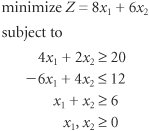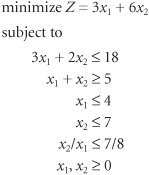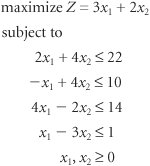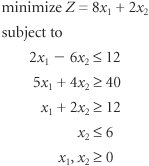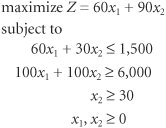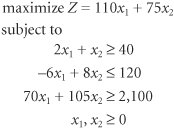Problems
| 1. | In Problem 28 in Chapter 1, when Marie McCoy wakes up Saturday morning, she remembers that she promised the PTA she would make some cakes and/or homemade bread for its bake sale that afternoon. However, she does not have time to go to the store to get ingredients , and she has only a short time to bake things in her oven. Because cakes and breads require different baking temperatures , she cannot bake them simultaneously , and she has only 3 hours available to bake. A cake requires 3 cups of flour, and a loaf of bread requires 8 cups; Marie has 20 cups of flour. A cake requires 45 minutes to bake, and a loaf of bread requires 30 minutes. The PTA will sell a cake for $10 and a loaf of bread for $6. Marie wants to decide how many cakes and loaves of bread she should make.
|
| 2. | A company produces two products that are processed on two assembly lines. Assembly line 1 has 100 available hours, and assembly line 2 has 42 available hours. Each product requires 10 hours of processing time on line 1, while on line 2 product 1 requires 7 hours and product 2 requires 3 hours. The profit for product 1 is $6 per unit, and the profit for product 2 is $4 per unit.
|
| 3. | The Munchies Cereal Company makes a cereal from several ingredients. Two of the ingredients, oats and rice, provide vitamins A and B. The company wants to know how many ounces of oats and rice it should include in each box of cereal to meet the minimum requirements of 48 milligrams of vitamin A and 12 milligrams of vitamin B while minimizing cost. An ounce of oats contributes 8 milligrams of vitamin A and 1 milligram of vitamin B, whereas an ounce of rice contributes 6 milligrams of A and 2 milligrams of B. An ounce of oats costs $0.05, and an ounce of rice costs $0.03.
|
| 4. | What would be the effect on the optimal solution in Problem 3 if the cost of rice increased from $0.03 per ounce to $0.06 per ounce? |
| 5. | The Kalo Fertilizer Company makes a fertilizer using two chemicals that provide nitrogen, phosphate, and potassium. A pound of ingredient 1 contributes 10 ounces of nitrogen and 6 ounces of phosphate, while a pound of ingredient 2 contributes 2 ounces of nitrogen, 6 ounces of phosphate, and 1 ounce of potassium. Ingredient 1 costs $3 per pound, and ingredient 2 costs $5 per pound . The company wants to know how many pounds of each chemical ingredient to put into a bag of fertilizer to meet the minimum requirements of 20 ounces of nitrogen, 36 ounces of phosphate, and 2 ounces of potassium while minimizing cost.
|
| 6. | The Pinewood Furniture Company produces chairs and tables from two resourceslabor and wood. The company has 80 hours of labor and 36 pounds of wood available each day. Demand for chairs is limited to 6 per day. Each chair requires 8 hours of labor and 2 pounds of wood, whereas a table requires 10 hours of labor and 6 pounds of wood. The profit derived from each chair is $400 and from each table, $100. The company wants to determine the number of chairs and tables to produce each day in order to maximize profit.
|
| | |
| 7. | In Problem 6, how much labor and wood will be unused if the optimal numbers of chairs and tables are produced? |
| 8. | In Problem 6, explain the effect on the optimal solution of changing the profit on a table from $100 to $500. |
| 9. | The Crumb and Custard Bakery makes coffee cakes and Danish pastries in large pans. The main ingredients are flour and sugar. There are 25 pounds of flour and 16 pounds of sugar available, and the demand for coffee cakes is 5. Five pounds of flour and 2 pounds of sugar are required to make a pan of coffee cakes, and 5 pounds of flour and 4 pounds of sugar are required to make a pan of Danish. A pan of coffee cakes has a profit of $1, and a pan of Danish has a profit of $5. Determine the number of pans of cakes and Danish to produce each day so that profit will be maximized.
|
| 10. | In Problem 9, how much flour and sugar will be left unused if the optimal numbers of cakes and Danish are baked? |
| 11. | Solve the following linear programming model graphically: |
| 12. | The Elixer Drug Company produces a drug from two ingredients. Each ingredient contains the same three antibiotics, in different proportions . One gram of ingredient 1 contributes 3 units, and 1 gram of ingredient 2 contributes 1 unit of antibiotic 1; the drug requires 6 units. At least 4 units of antibiotic 2 are required, and the ingredients each contribute 1 unit per gram. At least 12 units of antibiotic 3 are required; a gram of ingredient 1 contributes 2 units, and a gram of ingredient 2 contributes 6 units. The cost for a gram of ingredient 1 is $80, and the cost for a gram of ingredient 2 is $50. The company wants to formulate a linear programming model to determine the number of grams of each ingredient that must go into the drug in order to meet the antibiotic requirements at the minimum cost.
|
| 13. | A jewelry store makes necklaces and bracelets from gold and platinum. The store has 18 ounces of gold and 20 ounces of platinum. Each necklace requires 3 ounces of gold and 2 ounces of platinum, whereas each bracelet requires 2 ounces of gold and 4 ounces of platinum . The demand for bracelets is no more than four. A necklace earns $300 in profit and a bracelet, $400. The store wants to determine the number of necklaces and bracelets to make in order to maximize profit.
|
| 14. | In Problem 13, explain the effect on the optimal solution of increasing the profit on a bracelet from $400 to $600. What will be the effect of changing the platinum requirement for a necklace from 2 ounces to 3 ounces? |
| | |
| 15. | In Problem 13:
|
| 16. | A clothier makes coats and slacks. The two resources required are wool cloth and labor. The clothier has 150 square yards of wool and 200 hours of labor available. Each coat requires 3 square yards of wool and 10 hours of labor, whereas each pair of slacks requires 5 square yards of wool and 4 hours of labor. The profit for a coat is $50, and the profit for slacks is $40. The clothier wants to determine the number of coats and pairs of slacks to make so that profit will be maximized.
|
| 17. | In Problem 16, what would be the effect on the optimal solution if the available labor were increased from 200 to 240 hours? |
| 18. | Solve the following linear programming model graphically: |
| 19. | Transform the model in Problem 18 into standard form and indicate the value of the slack variables at each corner point solution. |
| 20. | Solve the following linear programming model graphically: |
| 21. | Transform the model in Problem 20 into standard form and indicate the value of the slack variables at each corner point solution. |
| 22. | Solve the following linear programming model graphically: |
| | |
| 23. | In Problem 22, if the constraint x 1 |
| 24. | Universal Claims Processors processes insurance claims for large national insurance companies. Most claim processing is done by a large pool of computer operators, some of whom are permanent and some of whom are temporary. A permanent operator can process 16 claims per day, whereas a temporary operator can process 12 per day, and on average the company processes at least 450 claims each day. The company has 40 computer workstations. A permanent operator generates about 0.5 claims with errors each day, whereas a temporary operator averages about 1.4 defective claims per day. The company wants to limit claims with errors to 25 per day. A permanent operator is paid $64 per day, and a temporary operator is paid $42 per day. The company wants to determine the number of permanent and temporary operators to hire in order to minimize costs.
|
| 25. | In Problem 24, explain the effect on the optimal solution of changing the daily pay for a permanent claims processor from $64 to $54. Explain the effect of changing the daily pay for a temporary claims processor from $42 to $36. |
| 26. | In Problem 24, what would be the effect on the optimal solution if Universal Claims Processors decided not to try to limit the number of defective claims each day? |
| 27. | In Problem 24, explain the effect on the optimal solution if the minimum number of claims the firm processes each day increased from 450 to at least 650. |
| 28. | Solve the following linear programming model graphically: |
| 29. | Solve the following linear programming model graphically: |
| 30. | In Problem 29, what would be the effect on the solution if the constraint x 2 |
| 31. | Solve the following linear programming model graphically: |
| | |
| 32. | Solve the following linear programming model graphically: |
| 33. | Solve the following linear programming model graphically: |
| 34. | Gillian's Restaurant has an ice-cream counter where it sells two main products, ice cream and frozen yogurt, each in a variety of flavors. The restaurant makes one order for ice cream and yogurt each week, and the store has enough freezer space for 115 gallons total of both products. A gallon of frozen yogurt costs $0.75 and a gallon of ice cream costs $0.93, and the restaurant budgets $90 each week for these products. The manager estimates that each week the restaurant sells at least twice as much ice cream as frozen yogurt. Profit per gallon of ice cream is $4.15, and profit per gallon of yogurt is $3.60.
|
| 35. | In Problem 34, how much additional profit would the restaurant realize each week if it increased its freezer capacity to accommodate 20 extra gallons total of ice cream and yogurt? |
| 36. | Copperfield Mining Company owns two mines, each of which produces three grades of orehigh, medium, and low. The company has a contract to supply a smelting company with at least 12 tons of high-grade ore, 8 tons of medium-grade ore, and 24 tons of low-grade ore. Each mine produces a certain amount of each type of ore during each hour that it operates. Mine 1 produces 6 tons of high-grade ore, 2 tons of medium-grade ore, and 4 tons of low-grade ore per hour. Mine 2 produces 2, 2, and 12 tons, respectively, of high-, medium-, and low-grade ore per hour. It costs Copperfield $200 per hour to mine each ton of ore from mine 1, and it costs $160 per hour to mine each ton of ore from mine 2. The company wants to determine the number of hours it needs to operate each mine so that its contractual obligations can be met at the lowest cost.
|
| 37. | A canning company produces two sizes of cansregular and large. The cans are produced in 10,000-can lots. The cans are processed through a stamping operation and a coating operation. The company has 30 days available for both stamping and coating. A lot of regular-size cans requires 2 days to stamp and 4 days to coat, whereas a lot of large cans requires 4 days to stamp and 2 days to coat. A lot of regular-size cans earns $800 profit, and a lot of large-size cans earns $900 profit. In order to fulfill its obligations under a shipping contract, the company must produce at least nine lots. The company wants to determine the number of lots to produce of each size can ( x 1 and x 2 ) in order to maximize profit.
|
| 38. | A manufacturing firm produces two products. Each product must undergo an assembly process and a finishing process. It is then transferred to the warehouse, which has space for only a limited number of items. The firm has 80 hours available for assembly and 112 hours for finishing, and it can store a maximum of 10 units in the warehouse. Each unit of product 1 has a profit of $30 and requires 4 hours to assemble and 14 hours to finish. Each unit of product 2 has a profit of $70 and requires 10 hours to assemble and 8 hours to finish. The firm wants to determine the quantity of each product to produce in order to maximize profit.
|
| 39. | Assume that the objective function in Problem 38 has been changed from Z = 30 x 1 + 70 x 2 to Z = 90 x 1 + 70 x 2 . Determine the slope of each objective function and discuss what effect these slopes have on the optimal solution. |
| 40. | The Valley Wine Company produces two kinds of wineValley Nectar and Valley Red. The wines are produced from 64 tons of grapes the company has acquired this season . A 1,000-gallon batch of Nectar requires 4 tons of grapes, and a batch of Red requires 8 tons. However, production is limited by the availability of only 50 cubic yards of storage space for aging and 120 hours of processing time. A batch of each type of wine requires 5 yd. 3 of storage space. The processing time for a batch of Nectar is 15 hours, and the processing time for a batch of Red is 8 hours. Demand for each type of wine is limited to seven batches. The profit for a batch of Nectar is $9,000, and the profit for a batch of Red is $12,000. The company wants to determine the number of 1,000-gallon batches of Nectar ( x 1 ) and Red ( x 2 ) to produce in order to maximize profit.
|
| 41. | In Problem 40:
|
| 42. | Kroeger supermarket sells its own brand of canned peas as well as several national brands. The store makes a profit of $0.28 per can for its own peas and a profit of $0.19 for any of the national brands. The store has 6 square feet of shelf space available for canned peas, and each can of peas takes up 9 square inches of that space. Point-of-sale records show that each week the store never sells more than one-half as many cans of its own brand as it does of the national brands. The store wants to know how many cans of its own brand of peas and how many cans of the national brands to stock each week on the allocated shelf space in order to maximize profit.
|
| 43. | In Problem 42, if Kroeger discounts the price of its own brand of peas, the store will sell at least 1.5 times as much of the national brands as its own brand, but its profit margin on its own brand will be reduced to $0.23 per can. What effect would the discount have on the optimal solution? |
| 44. | Shirtstop makes T-shirts with logos and sells them in its chain of retail stores. It contracts with two different plantsone in Puerto Rico and one in The Bahamas. The shirts from the plant in Puerto Rico cost $0.46 a piece, and 9% of them are defective and can't be sold. The shirts from The Bahamas cost only $0.35 each, but they have an 18% defective rate. Shirtstop needs 3,500 shirts. To retain its relationship with the two plants, it wants to order at least 1,000 shirts from each. It would also like at least 88% of the shirts it receives to be salable.
|
| 45. | In Problem 44:
|
| 46. | Angela and Bob Ray keep a large garden in which they grow cabbage, tomatoes, and onions to make two kinds of relishchow-chow and tomato. The chow-chow is made primarily of cabbage, whereas the tomato relish has more tomatoes than chow-chow. Both relishes include onions, and negligible amounts of bell peppers and spices. A jar of chow-chow contains 8 ounces of cabbage, 3 ounces of tomatoes, and 3 ounces of onions, whereas a jar of tomato relish contains 6 ounces of tomatoes, 6 ounces of cabbage, and 2 ounces of onions. The Rays grow 120 pounds of cabbage, 90 pounds of tomatoes, and 45 pounds of onions each summer. The Rays can produce no more than 24 dozen jars of relish. They make $2.25 in profit from a jar of chow-chow and $1.95 in profit from a jar of tomato relish. The Rays want to know how many jars of each kind of relish to produce to generate the most profit.
|
| 47. | In Problem 46, the Rays have checked their sales records for the past five years and have found that they sell at least 50% more chow-chow than tomato relish. How will this additional information affect their model and solution? |
| 48. | A California grower has a 50-acre farm on which to plant strawberries and tomatoes. The grower has available 300 hours of labor per week and 800 tons of fertilizer, and he has contracted for shipping space for a maximum of 26 acres' worth of strawberries and 37 acres' worth of tomatoes. An acre of strawberries requires 10 hours of labor and 8 tons of fertilizer, whereas an acre of tomatoes requires 3 hours of labor and 20 tons of fertilizer. The profit from an acre of strawberries is $400, and the profit from an acre of tomatoes is $300. The farmer wants to know the number of acres of strawberries and tomatoes to plant to maximize profit.
|
| 49. | In Problem 48, if the amount of fertilizer required for each acre of strawberries were determined to be 20 tons instead of 8 tons, what would be the effect on the optimal solution? |
| 50. | The admissions office at Tech wants to determine how many in-state and how many out-of-state students to accept for next fall's entering freshman class. Tuition for an in-state student is $7,600 per year, whereas out-of-state tuition is $22,500 per year. A total of 12,800 in-state and 8,100 out-of-state freshmen have applied for next fall, and Tech does not want to accept more than 3,500 students. However, because Tech is a state institution, the state mandates that it can accept no more than 40% out-of-state students. From past experience the admissions office knows that 12% of in-state students and 24% of out-of-state students will drop out during their first year. Tech wants to maximize total tuition while limiting the total attrition to 600 first-year students.
|
| | |
| 51. | Janet Lopez is establishing an investment portfolio that will include stock and bond funds. She has $720,000 to invest, and she does not want the portfolio to include more than 65% stocks. The average annual return for the stock fund she plans to invest in is 18%, whereas the average annual return for the bond fund is 6%. She further estimates that the most she could lose in the next year in the stock fund is 22%, whereas the most she could lose in the bond fund is 5%. To reduce her risk, she wants to limit her potential maximum losses to $100,000.
|
| 52. | Professor Smith teaches two sections of business statistics, which combined will result in 120 final exams to be graded. Professor Smith has two graduate assistants. Brad and Sarah, who will grade the final exams. There is a 3-day period between the time the exam is administered and when final grades must be posted. During this period Brad has 12 hours available and Sarah has 10 hours available to grade the exams. It takes Brad an average of 7.2 minutes to grade an exam, and it takes Sarah 12 minutes to grade an exam; however, Brad's exams will have errors that will require Professor Smith to ultimately regrade 10% of the exams, while only 6% of Sarah's exams will require regrading. Professor Smith wants to know how many exams to assign to each graduate assistant to grade in order to minimize the number of exams to regrade.
|
| 53. | In Problem 52, if Professor Smith could hire Brad or Sarah to work 1 additional hour, which should she choose? What would be the effect of hiring the selected graduate assistant for 1 additional hour? |
| 54. | Starbright Coffee Shop at the Galleria Mall serves two coffee blends it brews on a daily basis, Pomona and Coastal. Each is a blend of three high-quality coffees from Colombia, Kenya, and Indonesia. The coffee shop has 10 pounds of each of these coffees available each day. Each pound of coffee will produce sixteen 16-ounce cups of coffee. The shop has enough brewing capacity to brew 30 gallons of these two coffee blends each day. Pomona is a blend of 20% Colombian, 35% Kenyan, and 45% Indonesian, while Coastal is a blend of 60% Colombian, 10% Kenyan, and 30% Indonesian. The shop sells 1.5 times more Pomona than Coastal each day. Pomona sells for $2.05 per cup, and Coastal sells for $1.85 per cup. The manager wants to know how many cups of each blend to sell each day in order to maximize sales.
|
| 55. | In Problem 54:
|
| 56. | Solve the following linear programming model graphically and explain the solution result: |
| | |
| 57. | Solve the following linear programming model graphically and explain the solution result: |
| 58. | Solve the following linear programming model graphically and explain the solution result: |
EAN: 2147483647
Pages: 358

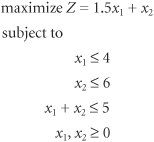


 8 is changed to
8 is changed to  8, what effect does this have on the feasible solution space and the optimal solution?
8, what effect does this have on the feasible solution space and the optimal solution? 